Design, Discovery and Connecting the Dots
Posted on 21st February 2017
Welcome to the Business Empathy Forum and thank you for your visit. In this post I dig deeper into the ‘Discovery’ aspect of innovation and highlight the role of personal empathy in that process. In doing so I also recommend a seminal research article – ‘The Innovator’s DNA’ – by Dyer, Gregersen, and Christensen, which first appeared in the ‘Harvard Business Review’ in 2009. A key insight of ‘The Innovator’s DNA’ is that innovation skills can actually be developed through our personal interactions and efforts to empathize with others.
Engaging Can Make Us More Innovative
To provide a conceptual framework for this discussion let us think of innovation as a three-step process consisting of Discovery, Design, and Delivery. In this simple framework ‘Discovery’ refers to finding out what the truly customer wants or needs, ‘Design’ is about designing the best product or service to fulfill that desire or need, and ‘Delivery’ means delivering that product or service in the most cost-efficient and profitable manner possible.
The authors of ‘The Innovator’s DNA’ shed light on the Discovery process by highlighting five ‘discovery skills’ that distinguish the outstanding innovative entrepreneurs of today’s business world. The skills they stress are questioning, observing, experimenting, networking, and associating. It seems to me that asking good questions, careful observation, experimenting, and mixing with people of diverse backgrounds and perspectives all speak for themselves: these actions will tend to open our minds to new ways of thinking and seeing the world. But the skill I would like to focus on is associating, which the authors assert is a key element of successful innovation: “Associating, or the ability to successfully connect seemingly unrelated questions, problems, or ideas from different fields, is central to the innovator’s DNA.”
Then they offer a connection that makes intuitive sense but which I had not really considered before. The authors assert that the more we question, observe, experiment, and network, the better we get at associating, at mixing and matching different ideas in new and interesting ways: “Associating is like a mental muscle that can grow stronger by using the other discovery skills. As innovators engage in those behaviors, they build their ability to generate ideas that can be recombined in new ways. The more frequently people in our study attempted to understand, categorize, and store new knowledge, the more easily their brains could naturally and consistently make, store, and recombine associations.”
This is encouraging for those of us who would like to be more innovative: the everyday acts of questioning, observing, experimenting, and networking also make us more adept at associating, at ‘connecting dots’ in original and exciting ways. In a fast moving digital world that demands ever more speed and innovation, this is good news. I encourage you to engage, empathize, discover, and connect those dots!
Good luck, and until next time…


